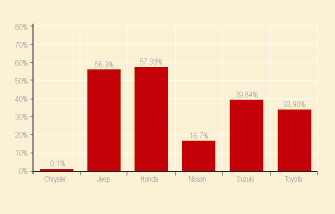In 1990, the then boss of PSA likened the UK to a “Japanese aircraft carrier off the coast of Europe” Now France is host to a big Japanese car factory and wishes it had more of them.
Nissan, the first transplant, has gone furthest to source its UK sales in Europe: 83% of its sales are of cars built in the region, of which the vast majority are made in Sunderland (see table). Only 40% of Suzukis now come from Japan and the Koreans are planning to follow a similar path, with Hyundai and Kia building factories in central Europe to supply a major proportion of their UK sales.
This raises two questions: why do companies want to assemble cars in supposedly high-cost Europe? And does that mean the European motor industry faces a challenge from lower-cost suppliers?
Experience has shown manufacturers that, if they want to be a major player in a region, they need to assemble there. This explains the growth of Japanese and Korean transplant factories in the USA. The cost of labour is less of an issue than commonly supposed. Direct labour is only about 10% of the cost of a modern car, so a Hyundai factory in America is not going to add a huge extra cost to a Sonata saloon.
In any case, a new factory means new working practices and no pensions or healthcare costs for retired workers. Also, the expansion of the EU means new factories can be set up in cost-effective countries in east Europe.
Slovakia will soon to have the world’s highest rate of car production based on population. But is the European car industry safe against low wage countries such as China? China, though, is not cheap, even though hourly pay for final assembly is under £1 anhour compared to £10 in the UK).
Because few local component suppliers can meet western standards, there are imports from advanced countries.
Car manufacturers are flooding into China because of its growth potential and, to a lesser extent, the rest of Asia. They do not expect to be shipping cars in huge quantities back to first-world markets. Honda has put a toe in the water by exporting the Jazz from China to mainland Europe but, earlier this month, it admitted that some cars required rectification to interior fit and finish upon arrival.
The Landwind scored zero in a recent German crash test and by the time China is up to Western standards of design and manufacture, its hourly pay will be closer to Western standards, too.
Europe has to compete with China on cost, and they with us on quality.

Chrysler is the most surprising example of what the Americans call “off-shoring” – sending production abroad. Although some come from low-cost Mexico, most UK-spec Chryslers are built in Austria, one of the highest cost countries. It shows there is a lot more to car manufacturing than finding a poor country and setting up a new factory there.














Login to comment
Comments
No comments have been made yet.